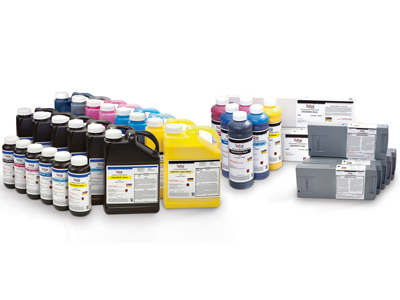The accountant will love them but your equipment supplier will most likely hate them: use of third party inks is said to be on the rise in the wide format sector. Digital Printer looks at the issues involved.
Third party inks in the wide format market can save a print company money and they might provide additional application options too, but they also have the potential to inflict a bad experience on a printer, with damage to the print head a typical outcome in such cases. For peace of mind therefore, a great many printers stick to the OEM-recommended inks, even though they usually cost more.
These are the choices that printers operating wide format equipment have, and according to Clive Harper of Ink & Print, which sells Van Son third party inks, increasing numbers of UK printers are choosing the third party option.
He told Digital Printer: ‘It’s an interesting market to be involved in and it’s a market that is growing. We started with it two years ago and probably grew 50% last year. In Southern Ireland, the majority use third party inks but in the UK it’s only 20-30%. I think people in the UK are a bit more cautious, but that is lifting to a degree.’
He said that companies might save as much as 30% on their ink costs by using third party inks instead of OEM, making its attraction obvious. These are not the only benefits though, according to Rich Dunklee, global market segment manager for Nazdar’s UV inkjet inks, who said that wider colour and adhesion gamuts can also be developed. ‘OEM inks are typically engineered for versatility, so that a user can get the most out of a piece of equipment,’ he said. ‘In developing a third party ink, we can take two different approaches. First, we can develop an ink that increases either the colour range of the OEM ink, or increases the variety of substrates that our ink will adhere to; sometimes we can achieve both. In other cases, we develop speciality inks that make one specific feature, like adhesion to a difficult substrate, even better.’

Clive Harper
Clive Harper observes that third party ink developers have been able to improve original OEM ink characteristics, and get them to market more quickly.
The fact is though that not all inks are made equal – a point that seems accepted by the third party ink manufacturers/suppliers and the OEM manufacturers – and this is where it gets confusing for the ink user, according to Epson’s Phil McMullin. ‘Some third party inks are quite good and some are not,’ he told Digital Printer. ‘Trying to find the right ones before you do damage to the printer is hit and miss, so I would caution against that as a supplier to the print industry. If you prefer peace of mind you are always safer with the genuine inks.’
Not surprisingly, Epson is ‘not a fan of third party inks’, Mr McMullin said, adding: ‘Our belief is that by designing the chassis, the print head and the inks we can control all aspects of the print experience for the customer and deliver consistent colour when they want it. We put a lot of effort into that and the two most important parts of the triangle are the piezo print head and the inks. We are researching and designing the ink sets that will be reliable through our print heads. We feel that if you change any component of that by putting third party inks in you are opening yourself up to inconsistency in the print process potentially. I’m not suggesting that some of the manufacturers are not producing them in a good environment, but we go to extreme measures to produce inks in clean rooms. Picture high tech facilities with people dressed in white suits, gloves and masks; temperature controlled rooms; no contamination: that’s the environment we are producing our inks in and we believe it’s critical in maintaining that consistency.’

Phil McMullin
When a customer has been using third party inks on an Epson printer and these have caused damage to it, the case is easily proven, he said, and the warranty will be invalidated. It is very clear how the issue has been caused when the company’s engineers do their analysis and interrogate the firmware.
Good and bad
There are a number of issues that arise from Mr McMullin’s words: the variable quality of third party inks, the degree of investment that such manufacturers can and do put into research and testing, and the invalidating of a machine warranty through (typically) damaging the print head.
Clive Harper from Ink & Print does not deny that there have been some bad experiences, saying that five or six years ago there were products coming from the Far East. ‘People got their fingers burnt; those inks were not ready for the market and that has stuck in people’s minds.’
‘The market is flooded with stories of experiences, both good and bad. The bad experiences tend to get the most attention,’ said Rich Dunklee.
Robin Titterington from Think Ink Solutions, which sells Imaginx wide format inks for Roland and Mimaki printers, accepted that ‘unfortunately there are good companies and there are bad ones that do not show the same degree of professionalism in either the development process, production and/or final QC process’, and Chris Bailey of Nazdar reseller QPS explained that some problems do not become apparent until the work is completed to switch to a third party ink. Problems can range from premature fading and loss of colour to UV ink adhesion issues resulting in ink films actually peeling away or cracking away from substrates.
Clearly, once a decision has been made to look into the third party ink market, it is important to research the potential suppliers. ‘Users should make sure that they are dealing with a reputable, established ink manufacturer for their third party inks, and one that offers an ink warranty,’ said Rich Dunklee of Nazdar. ‘They should be leery of offers of the lowest price from companies that don’t have a long history of making high quality inks. Nazdar has 90-plus years of experience in making high quality inks, the last 30 of which have included inks for the inkjet market. We maintain dedicated R&D and test lab facilities for the development and testing of UV, solvent, and water-based inks for inkjet products.’
Van Son is ‘very careful’ with its pigment selection, said Clive Harper, and would not introduce an ink without being certain of its suitability because of the potential damage to its name and reputation in the market place. The advice for printers from Robin Titterington is to ask the usual questions that they would ask of any supplier to make sure that it ticks all the boxes. He also recommended using companies that have a presence in Europe. ‘Inks are now made all over the world but unless they have a sales office or agent locally, I would not buy the ink,’ he said.
Most reputable third party ink suppliers will offer a warranty policy and full technical support. Nazdar claims to have the strongest warranty available from a third party ink supplier, and Rich Dunklee says that the company ‘guarantees exceptional product performance when used correctly, or we will repair or pay for the repair of your equipment’. Clive Harper said that while Ink & Print offers a warranty to cover for damage to a printing system caused by the use of its inks, no customer has ever had to fall back upon that warranty. It exists to give customers peace of mind and overcome the initial reluctance that some may feel to putting anything other than OEM inks through their printing system.
Better dialogue
The relationships between OEMs and third party ink suppliers appear to be somewhat patchy. Phil McMullin said that Epson would ‘absolutely not’ work with a third party ink developer, since it makes its own inks, and nor would it support a reseller that would sell third party inks. Clive Harper said that though there are some ink companies working with OEMs and sharing technology, the Van Son inks are developed completely independently. Chris Bailey of QPS said it will work with OEMs where possible and does so with Roland DG for dye sublimation applications.
‘The relationship between OEM and alternative ink suppliers continues to be good and bad,’ admitted Robin Titterington. ‘Some companies work very closely with OEMs and some, by the nature of the business, are known to the OEMs but not really liked, or should I say are dismissed. If they become a total nuisance or have products which are superior to those currently available, this tends to lead to a better dialogue. We do carry out work for some OEMs currently in various markets.’
At the end of the day, this comes down to peace of mind and value for money. From the OEM’s perspective, it wants to make money on its inks. Beyond that, why trust a brand enough to buy its printing technology and then take a risk on something as vitally important as the inks? This is the question that Phil McMullin puts forward.
The fact is however that a number of print companies do exactly this and are reaping the rewards. QPS puts forward several customer testimonials to confirm this, one of whom is Paul Austin, managing director of W.A.E Group, a Leeds-based sign printing firm. He said: ‘The inks are an exact colour and performance match to the OEM inks and the cost savings are obviously a key benefit to us. However, in order to make the business case work, it was crucial that the quality and adhesion of the inks was comparable to the OEM inks and this proved to be the case.’





